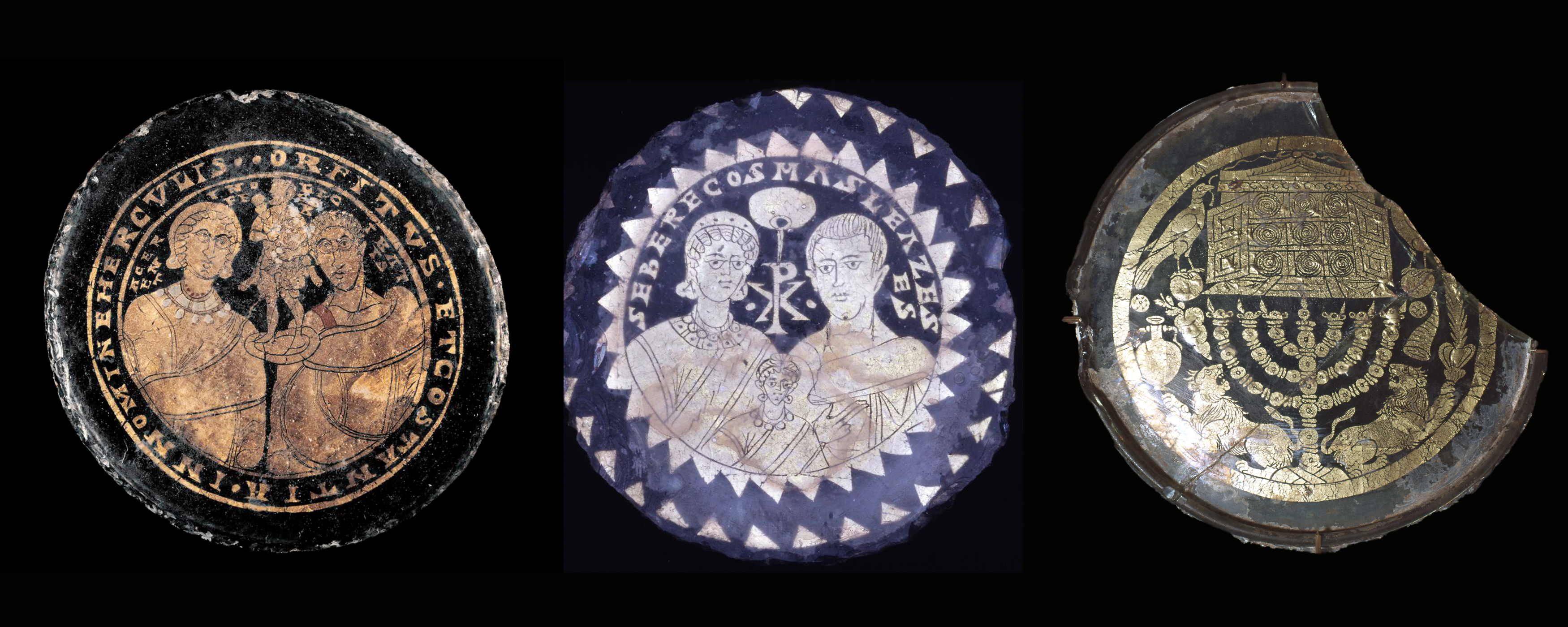
Jewish and Christian Co-produced Materiality in the Late Antique and Early Medieval West

Three gold-glass medallions from the catacombs of Rome. 1. Husband and wife with a small figure of Hercule, 4th C. (British Museum) 2. portrait of a family with a chrism, 3rd-5th C. (British Museum) 3. Two lions flanking a menorah and two peacocks flanking a Torah shrine, with other Jewish signs (shofar, etrog, lulav), 4th C. (Israel Museum in Jerusalem) inscription from n°1 : border : ORFITUS. ET COSTANTIA. IN NOMINE HERCVLIS inside : ACERENTINO FELICES BIBATIS inscription from n°2 : SEBERE COSMAS LEA ZESES
Picture a Roman sarcophagus workshop. The craftsman provides his customers with forms and iconographical compositions according to the prevailing trends of the period. However, the same workshops probably produced analogous sarcophagi for multiple religious groups, using comparable iconographical compositions which sometimes differed only in the incorporation of a Chrism or a menorah. Take the gold-glass medallions used to decorate the tombs in Rome's catacombs. They prominently showcase portraits of the deceased or the Christian martyrs, yet some bear distinctively Jewish signs (menorah, Torah shrines, etc.). And what can we say about the synagogue of Elche in Spain, which for so long was considered a Christian building because it followed the architectural type of a basilica usually used for churches since the 4th century?
This project approaches the idea of religious co-production in a very literal sense by studying the material productions of religious groups in the Late Antique and Early Medieval West by looking into:
- the manufacturing dynamics of objects that can be affiliated with a specific religion, such as shared workshops, or shared architectural forms and types of artifacts
- the exchange of forms, techniques, and iconography
By virtue of its reliance on the material record, archaeology not only affords access to a broader range of groups and societies than written sources do, but also permits the investigation of religious practices or changes in the liturgy that might be untraceable in written sources. Moreover, studying ancient religions via their material productions highlights the entangled every-day life of their members. Consider, for instance, the three gilded glass medallions that illustrate this text. We're dealing with artifacts used in the same place, for the same purpose (to decorate tombs), but each may be affiliated with different religious groups, such as Pagans (Hercules), Jews (Torah, Menorah, etc.), or Christians (Chrism). The medallion featuring the Chrism also bears the name Lea, suggesting that the family depicted may have had Jewish origins. This raises the following questions: How „fluid” were religious identities? Was this material co-production deliberate or unconscious depending on the actors involved (artist, customer, viewer)? Since the use of religious signs as „identity markers“ is emerging in this period, a fundamental question will be whether such religious signs are co-produced, or the effects of religious co-production.
The core of this project consists in the creation of a catalogue which reunites artefacts from established Jewish, Christian, or Muslim contexts, or which bears an iconography clearly recognizable as belonging to one of these groups. At the beginning, I will focus on western Jewish and Christian material culture between the 4th and 7th centuries CE, which is the general dating range for large collections of Late Antique material such as the catacombs. This broad geographical perspective and the chronological interval bridging Late Antiquity and the Early Middle Ages will also raise the question of the shared appropriation of „Pagan“ forms by Jews and Christians.